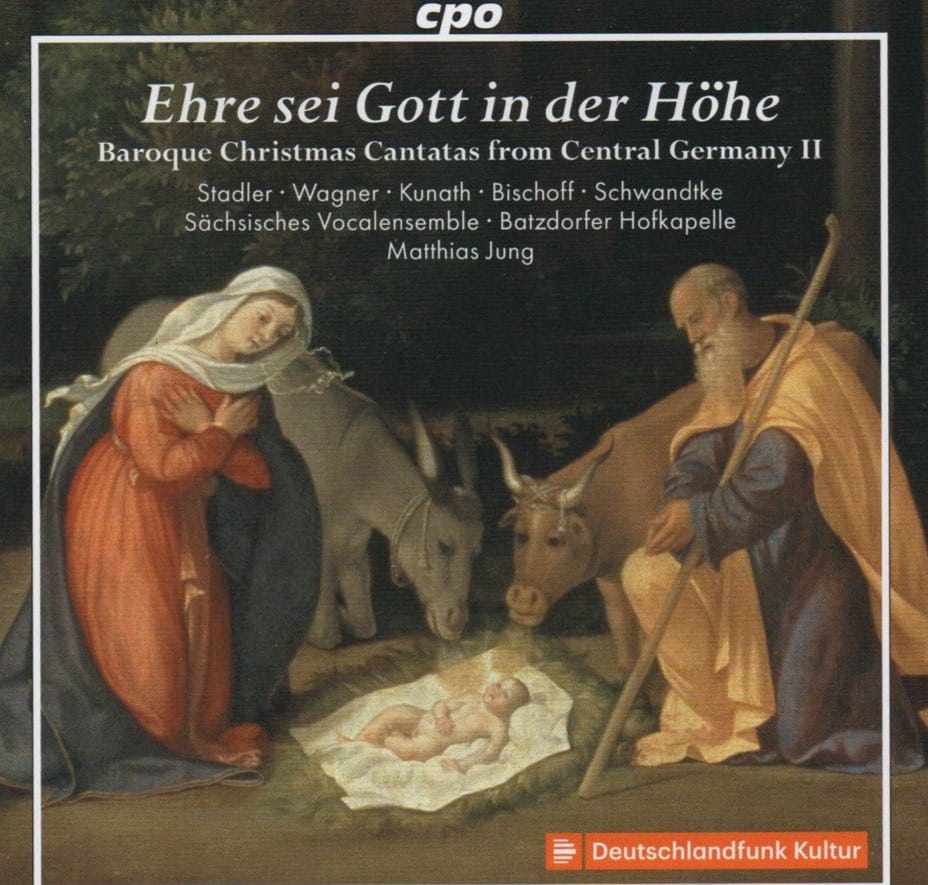“Ehre sei Gott in der Höhe” ... Baroque Christmas Cantatas from Central Germany
This is simultaneously a wonderful contribution to our understanding of the cantata, and a joyous celebration of the Christ birth

Of the five composers featured on this second volume from cpo of Baroque Christmas Cantatas from Central Germany, we met Johann Rosenmüller via his Magnificat and Sacred Concertos here. The remaining five are new to the site, and there is plenty to explore in this new release.
Johann Schelle (1648-1701) was a composer of the early-middle Baroque. The alternative title for this disc is “Christmas Cantatas from the Royal and State School of St. Augustin Grimma”. The disc also helps fill the gap between Baroque music between Schütz and J. S. Bach. The most famous Khetor of St Thomas', Leipzig was of course J. S. B.; Schelle was Thomascantor from 1677 until his death in 1701 (he was canto at Eilenburg before that). His Ehre sei Gott in Der Höhe, which is the first cantata heard here, is pretty much archetypal of the so-called “concerto-aria” cantata. An angel sings (multiple) songs of praise of the holy night, taken from Luke. Verses of unknown authorship sound between them, meditating on the meaning of Christmas. At various points we hear all five soloists on teh recording: sopranos Anna Stadler and Dorothea Wagner, alto Stefan Kunath, tenor Alexander Bischoff, and bass Felix Schwandtke. They are all excellent, but it is the spirit of the instrumental ensemble, the Batzdorfer Hofkapelle, that shines through under the inspired direction of Mathias Jung; a special mention for trumpeters Susan Williams and Helen Barsby, and for the tenor solos:
Schelle: Ehre sei Gott
There is a second cantata by Schelle on the programme, heard as the fifth item: Ach, liebster Jesu komm herein ((O dearest Jesus come to us), quite an interior piece with some lovely soprano solos; the third verse features Bishoff and Schwandtke, perfectly aligned in their responses:
Schelle: Ach leibester Jesu komm herein
The second cantata in spots sequence is by Christian Siegmund Liebe (1654-1708) and his Das neugeborne Kindelein. Born in Freiburg, Germany, he studied in Leipzig before moving to Dresden as a teacher.
Performed for the Celebration of the Epiphany of Christ in 1702, Das neugeborne Kindelein is a strophic setting of a text by Cyriacus Schneegass Liebe's writing is florid, teh mobile phrases speaking of heartfelt exuberance in this glowing performance. There ar two solo soprano parts, ably taken by Stadler and Wagner; Liebe plays with duos in this piece, be it two vocal soloists, two trumpets, two flutes, to delightful effect:
Liebe: Das neugeborne Kindelein
The third cantata is by Philipp Heinrich Erlebach (1657-1714), probably the best-known of the composers on this disc. The tragedy of Erlebach is we only have 70 compositions by him (out of what we know he wrote - over 1000!) because of a fire in 1735 that ate his manuscripts. His Das Wort ward Fleisch (The Word was made flesh) features a variety of Biblical texts (John, Like and a Psalm). The music is gentle and confident; The Sächsiches Vocalensemble is superb. Although Anne Stadler is the primary soloist (and listed as such) there are solo voices from teh choir too that shine (also, teh surname of teh composer is omitted in the English translation in the texts at the back of the booklet, uncharacteristic errors for this label). The Erlebach offers a centre of beauty to the disc, still with its moments of dynamism but overall conciliatory:
... and so to that Rosenmüller (see the beginning of this post for a link to our previous post on a whole disc of his music). This is beautiful: the only piece in Latin as opposed to German, Pure natus est nobis (A child is born) offers some lovely solos, for two violins and for bass (Felix Schwandtke). Another anomaly in the booklet, though: All other texts are Greman with English translation. The foregoes teh English and instead we have the original Latin translated into German (bunt English). However, this is yet another testament to why we should give our attention to Johann Rosenmüller's output. Listen out for the “Amen” with its exquisite trumpet playing in imitation with melismatic vocal soloists, surely oneofthe loveliest ”Amen”s out there:
The final cantata is by Gottfried Vogel (c. 1650-1711). It is the perfect lose: it is celebration in nature, as its title tests: Alleluja, Freuet such, ihr Christen all (Alleluia, Rejoice all ye Christians). The strophic nature of the text is followed exactly, but this regularity adds to the sense of bright security the piece offers. There seems to be precious little information about Gottfried Vogel around, sadly; it would be good to know if there is much more of his music available for recording. His cantata here is well-crafted and melodically infectious:
In sum, then, this is simultaneously a wonderful contribution to our understanding of the cantata, and a joyous celebration of the Christ birth.

